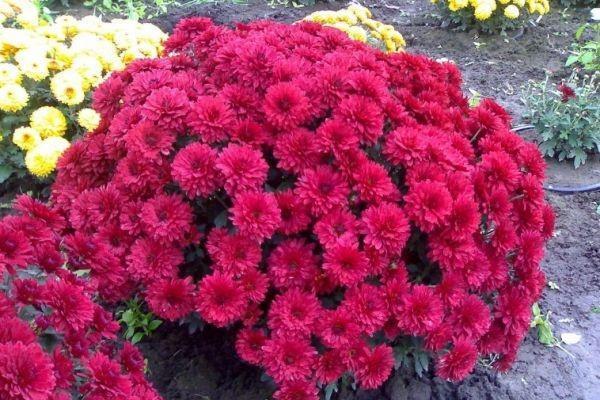Growing amazingly beautiful spherical chrysanthemums
 Ball-shaped chrysanthemums were bred by breeders to decorate flower beds in landscape design. They are not intended for wintering. Every year, the bushes must be either dug up and stored in a cool place, or well covered for the winter, mulching with dried flowers. This will help keep chrysanthemums from icing up. If you live in the northern regions of Russia, then you will only be able to grow a spherical chrysanthemum bush in a greenhouse or apartment. These flowers are wonderful indoor plants. If you plant them in a pots, then the spherical bush will grow strongly, and it can be divided.
Ball-shaped chrysanthemums were bred by breeders to decorate flower beds in landscape design. They are not intended for wintering. Every year, the bushes must be either dug up and stored in a cool place, or well covered for the winter, mulching with dried flowers. This will help keep chrysanthemums from icing up. If you live in the northern regions of Russia, then you will only be able to grow a spherical chrysanthemum bush in a greenhouse or apartment. These flowers are wonderful indoor plants. If you plant them in a pots, then the spherical bush will grow strongly, and it can be divided.
A feature of the spherical chrysanthemum is the poor survival rate of cuttings, therefore such a flower is propagated only by dividing the mother bush.
Features of growing chrysanthemums in the open field
In order for the chrysanthemum bush to retain its spherical shape, it must be divided every 2-3 seasons. The shoots of a three-year-old chrysanthemum are pinched into two internodes. This contributes to the formation of a spherical bush.
It is unacceptable to grow these flowers in partial shade. When chrysanthemums are planted in an insufficiently lit area, the plant begins to wither and sheds a large number of buds.
For abundant flowering, the chrysanthemum should be planted in an area where direct sunlight hits the bush for most of the day.
Fertilizers for chrysanthemums
Chrysanthemum - a plant of nocturnal development, it grows only in the evening. In central Russia, in September, there are often night frosts. The chrysanthemum bush does not tolerate cold weather. Therefore, in the fall, it must be transplanted into a greenhouse. For the same reason, chrysanthemums cannot be overfed with nitrogen. Otherwise, they will quickly grow and freeze out even before the winter cold. A lot of nitrogen is found in organic fertilizers: compost, humus, humus or herbal infusion. These fertilizers are applied to the soil in spring in very small doses. The best food for chrysanthemums - complex mineral fertilizers with a high content of potassium and magnesium, which have a positive effect on the formation of buds. If you do not want to use chemical fertilizers on your site, you can add potassium to the soil with the help of a banana peel. Eggshells can be a source of potassium and calcium. Embed it in the soil, and the shell gradually begins to release calcium and potassium.
During bud formation, chrysanthemums are vulnerable to powdery mildew. For the prevention of fungal diseases, it is necessary to spray the bushes with Bordeaux liquid and apply magnesium-containing fertilizers to the soil.